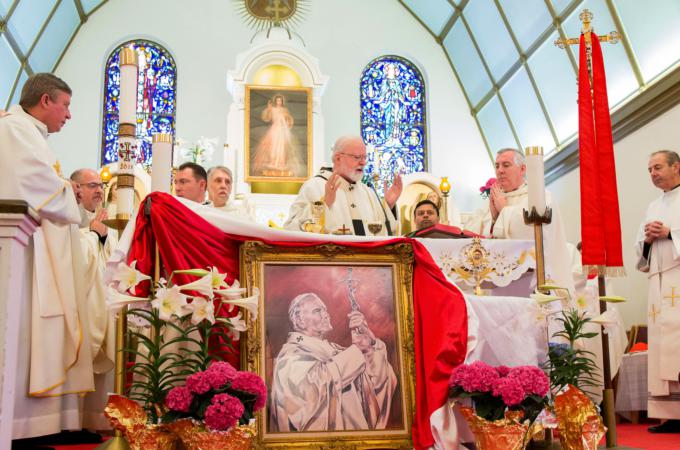Salem shrine receives St. John Paul II relic
SALEM -- Salem was abuzz on April 8 with camera crews, reporters, photographers, and crowds of people from neighboring cities and beyond. Yet, it wasn't one of Salem's many occult attractions that drew people there; indeed, it was just the opposite. It was Divine Mercy Sunday, and hundreds gathered at St. John Paul II Shrine of Divine Mercy for a Mass celebrated by Cardinal Seán P. O'Malley, during which he presented the shrine with a first-class relic of its namesake -- St. Pope John Paul II.
"One of the greatest works in the Church is mercy," said the cardinal during his homily.
The theme of mercy, "that is so central in the pontificate of Pope Francis, is also reflected in the ministry of St. John Paul II, who lifted up the Divine Mercy message of St. Faustina and shared it with the world," he said.
St. John Paul II Shrine of Divine Mercy sits at the center of Salem, close to the Peabody Essex Museum and on a route of one of the town's many "haunted" tours. Erected August of last year, the shrine is housed in what was formerly St. John the Baptist Church, a Polish national parish.
The shrine, dedicated to Polish saints St. Faustina and St. John Paul II, was formed in part to keep its Polish heritage intact. It is also dedicated to Divine Mercy, a devotion revealed to St. Faustina and further promulgated by St. John Paul II, who established Divine Mercy Sunday, the shrine is meant to be a place of Eucharistic adoration and prayer, a place that will stand in contrast to Salem's association with occult and dark magic.
"We are so grateful for the presence of this shrine that will make more present in the minds and the hearts of our Catholic people the message of divine mercy and the call to holiness that St. Faustina and Pope John Paul II proclaimed," said Cardinal O'Malley in his homily.
Presented and blessed during the Mass, the first-class relic of St. John Paul II is a vial of his blood, housed within an ornate reliquary. It was the personal relic of Cardinal O'Malley, who received it after the saint was beatified in 2011.
As a young priest, the cardinal said, he was inspired by St. John Paul II, the way the pope would take the time to be available to the people, to hear their stories and speak with them. It was the late pope who would go on to appoint Cardinal O'Malley bishop in four different dioceses.
He was an "extraordinary saint; his priestly heart, his deep faith, and the brilliant mind of a man whose relic I bring you today," said the cardinal.
The Mass, attended by hundreds, was held in the shrine's upper church and broadcast live to the lower church, which has an area dedicated to St. Faustina, and contains a first-class relic of her. Concelebrants included Bishop Mark O'Connell, Father Pawel Bandurski, provincial of the Society of Christ in America, and Father Robert Bedzinski, the shrine's rector and a priest of the Society of Christ.
Readings were proclaimed in Polish and English, and many of the attendees were of Polish descent.
Cardinal O'Malley, in addition to the relic, also presented the shrine with a chalice St. John Paul II, originally given Cardinal Humberto Medeiros, which was used during the Mass.
At the closing of the Mass, members of the shine community, some wearing traditional Polish clothing, presented gifts to Father Bandurski, Bishop O'Connell, and Cardinal O'Malley in thanks for their support.
The Mass was "beautiful," said Maryla Konarski of Middleton. "It was amazing for me." She had held up an image of St. John Paul II at the end of the Mass, raising it high with a beaming smile on her face.
The Mass ended following a message of gratitude from Father Bedzinski and the imparting of the apostolic blessing, along with the plenary indulgence attached to it, from Cardinal O'Malley.
A message from Bishop Wieslaw Lechowicz of Poland, the delegate of the Polish Conference of Bishops to communities throughout the world, was read to those gathered by Father Bandurski. The bishop had been invited to concelebrate at the Mass, but was unable to attend.
"On behalf of all the faithful of the Polish origin, on my own behalf and of the Polish bishops, I'd like to express my profound gratitude for establishing the Shrine of Divine Mercy in Salem," the bishop said in his message.
He went on to thank the Archdiocese of Boston and Cardinal O'Malley "for understanding the religious needs of the Polish faithful and for respecting the Polish speaking pastoral care."
Those gathered were able to venerate the relic following the Mass and were invited to a luncheon complete with an array of Polish foods.
Parishioner Darrin Potorski was one of the many who venerated the relic. A Peabody resident of Polish descent, Potorski came with fellow members of a Polish veterans' organization in the area. He said three such organizations were represented at the Mass.
The opportunity to venerate the relic, Potorski said, was "kind of a once in a lifetime thing."
"To have something of that magnitude is just incredible," he said of the relic. "God bless Cardinal O'Malley and the groups who made it possible."
A period of Eucharistic adoration was held, before a procession of the live Stations of the Cross was made through the streets of Salem.
The cross, heavy and made of wood, was carried by at least four people at one time. People rotated out after stopping for each station, so that many of those processing had the opportunity to carry, at least for a short distance, a small part of the burden Christ had the bear. The day concluded with the praying of the Divine Mercy Chaplet.



















